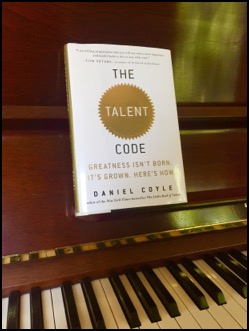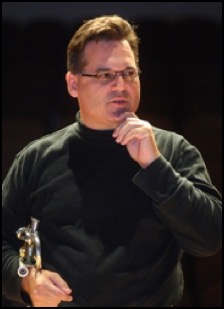Coyle
The Talent Code
12/09/15 Filed in: Review

Coyle identifies three key elements to learning:
- Chunk it
- Repeat it
- Feel it (concentrate)
The first technique described is 'chunking'--yes, that is the actual name coined by psychologists--and it is simply the idea of taking a small piece of a larger task, mastering that piece, then moving on to the next part of the task.
The brain learns through repetition, with each repetition adding a layer of myelin to a set of synapses, thereby making them more efficient the next time that activityis repeated. The myelin will layer on undesireable activity just as easily as a preferred activity, so it is important to be accurate. The sweet spot is 'deep practice,' where one is struggling at the edge of one's abilities, thus fully engaging one's concentration; in these circumstances, synapses fire more quickly, creating more myelin.
The third technique, concentration, is perhaps the most important--it is the gateway to deep practice. If you simply 'play though' your piece, you are training yourself not to pay attention. Remember, deep concertration layers on more myelin.
The Talent Code is written to be applicable to any field, and yet Coyle draws enough examples from music that one can come away with specific practice techniques. Coyle went to the string camp Meadowmount and describes a few chunking techniques used there:
- Changing running eighth notes into a dotted rhythm--micro chunking--forcing your brain to master two notes above tempo, then allowing a small 'rest' before tackling the next two notes.
- Cutting a score into one-stave strips, then randomly pulling those strips out of an envelope forcing a more macro chunking. (In this instance setting a limited, specific, immediately attainable goal, thereby forcing concentration on a limited task, may be as important as the 'chunking.')
Coyle goes on to examine the techniques of great coaches and teachers and finds four fundamental elements:
- The coach/teacher needs a thorough understanding of the material (what Coyle calls the "matrix").
- Perceptiveness: the teacher must not simply observe errors, but understand their causes so they may be pulled put by the roots (hence the need for the matrix of knowledge).
- The teacher must provide hyper-direct and immediate feed back that is specific, praises the good, and identifies the bad.
- The teacher must exhibit a theatrical honesty: criticism must be honest, though not necessarily fair. They must praise their worst student for an acheivement that they would criticize in their best, meaning, and push each individual to their next step.
Finally Coyle tells us to explain the brain to our students:
"Tell [your students] how myelin works. Carol Dweck split seven hundred low-achieving middle schoolers into two groups. The first were given an eight-week workshop of study skills; the second were given the identical workshop along with something extra: a fifty-minute session that described how the brain grows when it is challenged. Within a semester the second group had significantly improved their grades and study habits. The experimenters didn't tell the teachers which group the kids were in, but the teachers could tell anyway. " --page 217
